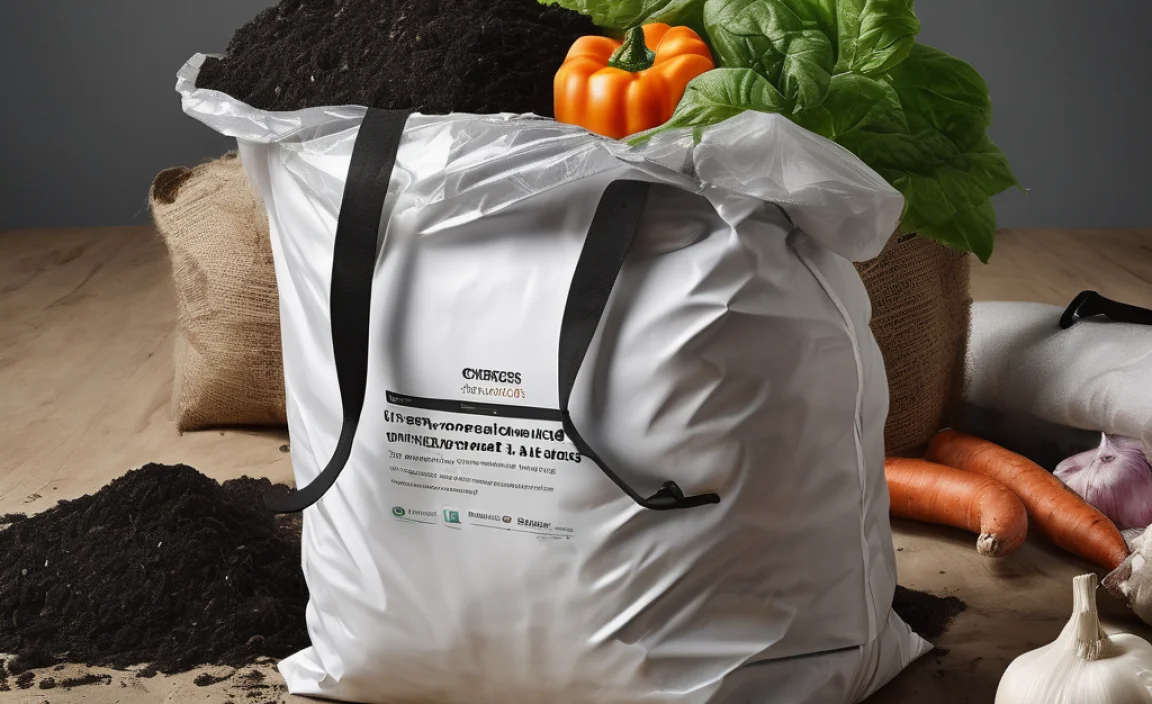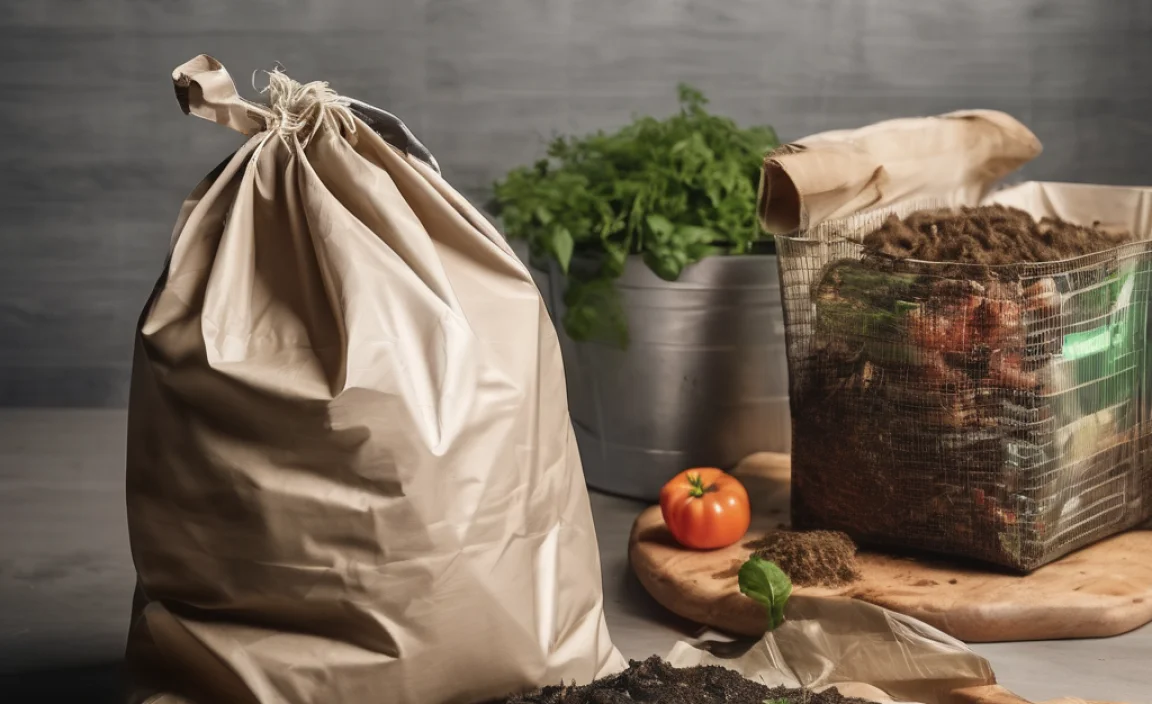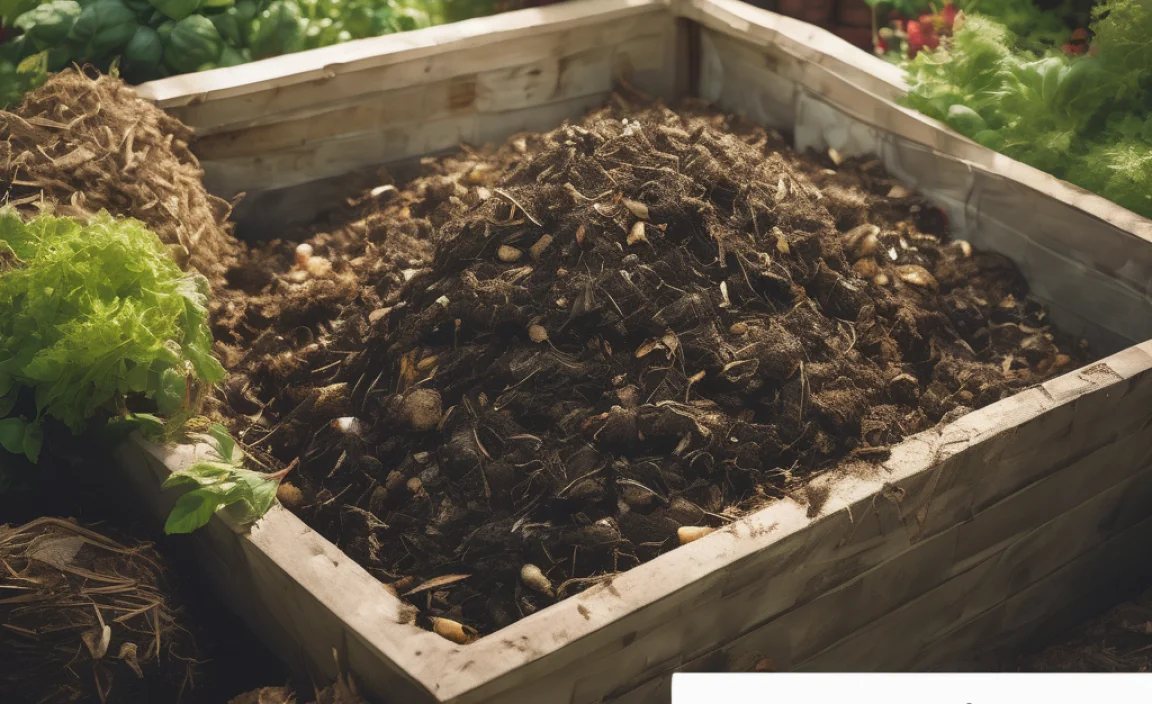Thinking about composting but feeling a bit lost in the world of eco-friendly solutions? You’re not alone! Many folks wonder about the best way to manage their kitchen scraps and garden waste, especially when they see terms like “compost bags” pop up. It can seem like another thing to figure out when you just want to do something good for the planet. Don’t worry, I’ve got your back! This guide is designed to make compost bags in Europe super simple. We’ll break down exactly what they are, why you might need them, and how to use them like a pro. Get ready to feel confident about your composting journey!
Compost Bags in Europe: Your Easy-to-Understand Guide
Hey there, fellow home improvers and garden enthusiasts! Troy D Harn here, your go-to guy for making all those DIY, gardening, and composting tasks feel like a breeze. Today, we’re diving into something that might sound a little niche but is super useful for many of us trying to be a bit greener: compost bags in Europe. If you’ve ever felt overwhelmed by composting options or just wanted a simple way to collect your food scraps, you’re in the right place. We’ll break down what these bags are all about, why they’re becoming so popular across the pond, and how you can easily integrate them into your routine. No complicated jargon, just practical advice to help you compost with confidence!
Many of us are becoming more aware of our environmental footprint. Food waste is a big part of that, and composting is a fantastic way to reduce it. But where do you start, especially if you live in an apartment or a smaller home? That’s where compost bags come in. They offer a convenient, hygienic, and often mandated solution for collecting organic waste, particularly in many European countries.
What Exactly Are Compost Bags?

Simply put, compost bags are bags designed specifically to hold organic waste. They’re not your average plastic bin liner. These bags are usually made from biodegradable or compostable materials, meaning they break down naturally over time. This is crucial because they are often collected by local authorities for industrial composting facilities. Think of them as specially designed containers that help keep your food scraps neat and tidy until pickup time.
The primary goal of these bags is to make the separation of food waste easy and hygienic for households. They prevent leaks and odors, making the process much more pleasant than using a standard bin. In many parts of Europe, separating food waste is a legal requirement, and providing certified compostable bags is a common part of the municipal waste management system.
Why Are Compost Bags Used in Europe?

Europe has been at the forefront of waste management innovation for decades. The emphasis on reducing landfill waste and increasing recycling and composting rates is a major driving force behind the widespread use of compost bags. Here’s why they’ve become so essential:
- Environmental Regulations: Many European countries have strict regulations on waste disposal. Diverting organic waste from landfills is a key objective to reduce methane gas emissions, a potent greenhouse gas. Compost bags are a practical tool to facilitate this separation at the source – your home.
- Hygiene and Odor Control: Kitchen scraps can be messy and smelly. Compostable bags are designed to contain liquids and minimize odors, making the process of storing and transporting organic waste much cleaner for residents.
- Industrial Composting Compatibility: The bags are typically certified to meet specific European standards (like EN 13432). This ensures they break down effectively in industrial composting facilities, alongside the food waste they contain. This integration is vital for the success of municipal composting programs.
- Promoting a Circular Economy: By collecting and processing food waste, Europe promotes a circular economy. The compost generated from this waste can be used to enrich soil, reduce the need for synthetic fertilizers, and support local agriculture and green spaces. For more on this, you can check out the European Commission’s page on the Circular Economy.
- Convenience: For many households, especially those in urban settings or apartments, these bags offer a simple and straightforward way to participate in organic waste programs without needing large, dedicated composting bins.
Types of Compost Bags Available

When you’re looking for compost bags, especially in Europe, you’ll likely encounter a few main types. It’s important to know the difference to ensure you’re using the right ones for your local waste collection system.
Certified Compostable Bags
These are the gold standard for most municipal composting programs in Europe. They are certified to break down completely in industrial composting environments.
- Material: Typically made from plant-based materials like corn starch (PLA – Polylactic Acid) or PHA (Polyhydroxyalkanoates).
- Certification: Look for certifications like EN 13432 (European Standard for compostable packaging) or TÜV AUSTRIA’s OK Compost Industrial logo. This logo is a strong indicator that the bag will break down in a commercial facility.
- What to do: Fill them with your food scraps and place them in your designated organic waste bin for collection.
Biodegradable Bags (Use with Caution)
The term “biodegradable” can sometimes be misleading. While these bags are designed to break down, the timeframe and conditions required can vary greatly. Some might break down in a natural environment but not quickly enough for industrial composting, or they might leave behind microplastics.
- Material: Can be made from various materials, some of which may still contain plastics or additives that hinder complete degradation.
- Certification: Less rigorously regulated than compostable bags. Be skeptical without clear, verifiable composting certifications.
- What to do: Generally, if your municipality specifies “compostable bags,” avoid “biodegradable” bags unless they explicitly meet the required composting standards.
Paper or Starch-Based Kitchen Caddy Liners
These are often used as liners for small kitchen caddies (the small bins you keep on your counter). They are usually designed to be compostable.
- Material: Often made from paper or starch-based materials.
- Certification: Should also ideally have composting certifications.
- What to do: Useful for lining your kitchen caddy to make emptying it easier. These can often go directly into your larger organic waste bin.
Understanding Key Certifications

Certifications are your best friend when choosing compost bags in Europe. They take the guesswork out of knowing if a bag will actually compost properly.
The most important standard to look for is EN 13432. This European standard specifies the requirements for packaging recoverable through composting and/or biodegradation. A product meeting this standard must:
- Disintegrate completely within a set timeframe.
- Be “biodegradable” – meaning it breaks down into natural elements.
- Not produce “ecotoxicity” – it shouldn’t harm living organisms.
- Not produce “persistent” or “negative visual impact” fragments.
You’ll often see logos from certifying bodies under the EN 13432 umbrella. The TÜV AUSTRIA OK Compost INDUSTRIAL logo is particularly common and trustworthy. It confirms that the product is suitable for industrial composting facilities in Europe.
Here’s a quick comparison of what to look for:
| Bag Type | Key Features | Certification to Look For | Best For |
|---|---|---|---|
| Certified Compostable Bags | Plant-based, meet strict breakdown requirements. | EN 13432, OK Compost INDUSTRIAL | Municipal organic waste collection. |
| Biodegradable Bags (General) | Break down over time, but conditions vary. | Varies, often lacks specific composting standards if not certified. | Use with caution; check local guidelines carefully. May not be suitable for industrial composting. |
| Paper/Starch Liners | Absorbent, easy to use in kitchen caddies. | Ideally compostable certifications (EN 13432). | Lining kitchen caddies, then placed in larger bin. |
How to Use Compost Bags Effectively

Using compost bags is pretty straightforward, but a few tips can make the process even smoother and more effective.
Step 1: Check Your Local Guidelines
This is the MOST important first step. Different municipalities have different rules. Some might only accept certain types of bags or have very specific collection schedules. Visit your local council’s website or waste management provider’s page. Search for terms like “food waste collection,” “organic waste,” or “bio-waste.” Often, they will specify which certifications or types of bags are permitted. For example, the UK government provides guidance on recycling collections, and similarly, local authorities across Europe will have their own detailed information.
Step 2: Choose the Right Bags
Based on your local rules, purchase certified compostable bags. Look for the EN 13432 certification or a similar recognized mark. Buying in bulk can often save money. Make sure you’re buying bags that are appropriately sized for your organic waste bin.
Step 3: Line Your Bin
Use the compost bag to line your kitchen caddy or the designated outdoor organic waste bin. This helps prevent food from sticking to the bin and makes cleaning much easier. If you have a small kitchen caddy, you might use a small compostable liner inside that, and then place the entire caddy contents into your main outdoor bin.
Step 4: Collect Your Organic Waste
Start filling the bag with your food scraps! This includes:
- Fruit and vegetable peels
- Tea bags and coffee grounds
- Eggshells (crushed)
- Leftovers (bread, pasta, rice – in moderation and only if your program accepts them)
- Plate scrapings (without excessive grease or non-organic materials)
- Certain garden waste (check local rules – e.g., small amounts of grass clippings or leaves)
What NOT to put in:
- Plastic bags (unless specifically approved)
- Non-compostable packaging
- Meat, fish, and dairy (often not accepted in household collections due to potential for pests and smell, though some industrial facilities can handle them – always check your local rules!)
- Oils and fats
- Diapers or sanitary products
- Glass, metal, or plastic
Step 5: Seal and Dispose
Once the bag is full, tie it shut securely. This helps contain any remaining odors and prevents spills. Place the sealed bag into your communal or household organic waste bin.
Step 6: Bin Maintenance
Even with a bag, it’s a good idea to rinse your bin occasionally, especially the main outdoor bin, to keep it clean and odor-free. A simple rinse with water and possibly a bit of mild soap is usually sufficient.
Pros and Cons of Using Compost Bags
Like any solution, compost bags have their upsides and downsides. Understanding these will help you decide if they fit your lifestyle and composting goals.
Pros:
- Convenience: Extremely easy to use for collecting food scraps in the kitchen.
- Hygiene: Helps contain liquids and odors, making the process more pleasant.
- Compliance: Essential for meeting mandatory organic waste separation requirements in many European regions.
- Biodegradability: When certified, they break down properly in industrial composting facilities, contributing to waste diversion.
- Accessibility: Widely available in supermarkets and online across Europe.
- Reduces Landfill Waste: Directly supports efforts to keep organic matter out of landfills, reducing methane emissions.
Cons:
- Cost: Certified compostable bags can be more expensive than regular bin liners.
- Improper Disposal: If non-certified bags are used, or if bags end up in landfill or recycling streams, they can cause contamination and negate the benefits.
- Durability: Some bags, especially when overloaded or kept for too long, can become leaky or tear.
- Availability of Facilities: The system relies on local authorities having robust industrial composting facilities that can process these bags effectively.
- “Greenwashing”: The term “biodegradable” can be used loosely, leading to confusion about what truly breaks down in a composting environment.
Tips for a Greener Composting Experience
Beyond just using the right bags, here are some extra tips to boost your composting game:
- Reduce Moisture: If your scraps are very wet, you can line the bottom of your compost bag with a bit of newspaper or a paper towel to absorb excess moisture. This can help prevent leaks and odors.
- Freeze Scraps: If you don’t fill your bag quickly or want to reduce smells between collections, you can freeze your food scraps in a small container or directly in a spare compost bag. Put them in the freezer and transfer them to your main collection bin on collection day.
- Small, Frequent Emptying: For kitchen caddies, emptying them more frequently (daily, if possible) into the main outdoor bin can significantly reduce smells and the chance of bags degrading too quickly.
- Proper Bin Placement: If you have an outdoor organic waste bin, make sure it has a tight-fitting lid to deter pests. Keeping it in a shaded spot can also help prevent it from getting too hot, which can sometimes degrade bags faster.
- Educate Yourself and Others: Understand what goes in and what stays out. Share this knowledge with family members or housemates to ensure everyone is on the same page.
Compost Bag Alternatives
While compost bags are convenient, they aren’t the only way to manage your food waste. Depending on your living situation and local facilities, you might consider:
- No Bag at All: Some people simply place food scraps directly into their designated organic waste bin. Ensure your bin is cleaned regularly to maintain hygiene. This is often the most straightforward approach if your bin is collected frequently.
- Newspaper or Paper Bags: For very dry scraps, or if you’re using a smaller kitchen caddy, wrapping scraps in newspaper or using plain paper bags can work. However, this is less effective for wet waste and may not be suitable or accepted by all collection services.
- Home Composting: If you have a garden, setting up a compost bin or heap at home is a fantastic way to turn food and garden waste into valuable compost for your own use. This bypasses the need for municipal collection bags altogether. Organizations like The Royal Horticultural Society (RHS) offer excellent advice on home composting.
- Worm Composting (Vermicomposting): This is a great option for smaller spaces and even apartments. Special worms process food scraps in a bin, producing nutrient-rich worm castings.
The best alternative to compost bags is the one that works for your specific circumstances and is accepted by your local waste management system.
Frequently Asked Questions About Compost Bags in Europe
Here are some common questions beginner composters often have:
Q1: Are all “green” or “eco” bags compostable?
A: Not necessarily! The terms “biodegradable,” “compostable,” and “eco-friendly” can be used loosely. Always look for specific certifications like EN 13432 or the OK Compost INDUSTRIAL logo to ensure they are suitable for industrial composting facilities in Europe. Generic “biodegradable” claims may not meet the required standards.
Q2: How long do compost bags take to break down?
A: Certified compostable bags are designed to break down within 90 days under industrial composting conditions, meeting the EN 13432 standard. In a landfill or home compost bin, the breakdown time can be much longer or may not occur effectively.
Q3: What happens if I use a regular plastic bag for my food waste?
A: Using regular plastic bags can contaminate the organic waste stream. These bags don’t break down in industrial composting facilities and can disrupt the composting process, potentially leading to the entire batch being sent to landfill. It’s also often against local regulations.
Q4: Can I put meat, fish, or dairy in compost bags?
A: This depends heavily on your local collection service. While many industrial composting facilities can handle these items, some municipal programs (especially those for household collections) prohibit them due to the risk of attracting pests and causing odors. Always consult your local waste management guidelines.
Q5: Where can I buy certified compost bags in Europe?
A: Certified compost bags are widely available. You can typically find them in major supermarkets, hypermarkets, DIY stores, and online
.lwrp.link-whisper-related-posts{
margin-top: 40px;
margin-bottom: 30px;
}
.lwrp .lwrp-title{
}.lwrp .lwrp-description{
}
.lwrp .lwrp-list-container{
}
.lwrp .lwrp-list-multi-container{
display: flex;
}
.lwrp .lwrp-list-double{
width: 48%;
}
.lwrp .lwrp-list-triple{
width: 32%;
}
.lwrp .lwrp-list-row-container{
display: flex;
justify-content: space-between;
}
.lwrp .lwrp-list-row-container .lwrp-list-item{
width: calc(25% – 20px);
}
.lwrp .lwrp-list-item:not(.lwrp-no-posts-message-item){
max-width: 150px;
}
.lwrp .lwrp-list-item img{
max-width: 100%;
height: auto;
object-fit: cover;
aspect-ratio: 1 / 1;
}
.lwrp .lwrp-list-item.lwrp-empty-list-item{
background: initial !important;
}
.lwrp .lwrp-list-item .lwrp-list-link .lwrp-list-link-title-text,
.lwrp .lwrp-list-item .lwrp-list-no-posts-message{
}@media screen and (max-width: 480px) {
.lwrp.link-whisper-related-posts{
}
.lwrp .lwrp-title{
}.lwrp .lwrp-description{
}
.lwrp .lwrp-list-multi-container{
flex-direction: column;
}
.lwrp .lwrp-list-multi-container ul.lwrp-list{
margin-top: 0px;
margin-bottom: 0px;
padding-top: 0px;
padding-bottom: 0px;
}
.lwrp .lwrp-list-double,
.lwrp .lwrp-list-triple{
width: 100%;
}
.lwrp .lwrp-list-row-container{
justify-content: initial;
flex-direction: column;
}
.lwrp .lwrp-list-row-container .lwrp-list-item{
width: 100%;
}
.lwrp .lwrp-list-item:not(.lwrp-no-posts-message-item){
max-width: initial;
}
.lwrp .lwrp-list-item .lwrp-list-link .lwrp-list-link-title-text,
.lwrp .lwrp-list-item .lwrp-list-no-posts-message{
};
}

I am passionate about home engineering. I specialize in designing, installing, and maintaining heating, ventilation, and air conditioning systems. My goal is to help people stay comfortable in their homes all year long.

